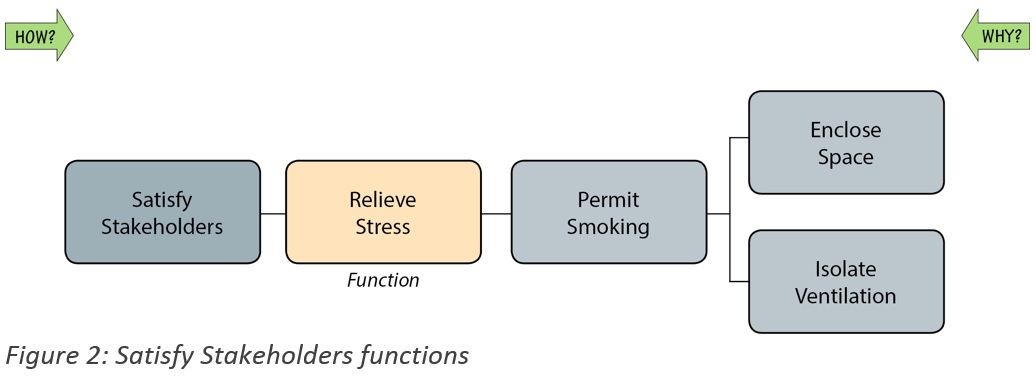By Muthiah Kasi, PE, SE, CVS-Life
Stakeholders have conflicting needs, desires or constraints. Owners, Planners and Designers have to address these conflicting needs, desires and constraints. Airport authorities need to balance between security and passenger convenience. Highway engineers have to deal with -traffic speeds and neighborhood access. When developing a function model, conflicting functions can be classified under enhancing functions of a project.
It is important to understand the stakeholder’s role in the project along with their needs and desires. This helps to improve the worth of the project, product or process.
For example, some major airport terminals have signs posted stating “Smoke Free Terminals.” Yet you may see in some airports designated smoking area. The activities that are associated with the two scenarios presented below are Prohibit Smoking and Permit Smoking. To understand the functions behind these activities, apply the How?-Why? Logic. The functions behind the action Prohibit Smoking is Preserve Health or Protect Environment. The function behind the action Permit Smoking is Relieve Stress.
Scenario 1: Addresses Permit Smoking and Prohibit Smoking
The majority of the passengers consider a smoke-free area as part of a health preservation need. The function Preserve Public Health is classified as an Assure Dependability function in the Function Model (see Figure 1).

Whereas passengers that are smokers consider it as their desire to relax or relieve stress. Airport authorities classify the function Relieve Stress as a Satisfy Stakeholder function (see Figure 2). In this case, the authority are permitting smoking.

Scenario 2: Permit Smoking is an option
The Owner may look at enclosing a space for smokers as a Preserve Health function for other nonsmokers. This protects the non-smokers from the second hand smoke effect. In this case the Function Model will be as shown in Figure 3. Exclude Smoke may be achieved either by isolating a smoking area or by not permitting smoking. Function classification reflect the owner’s perspective of any activity or function. In the Scenario 1, the conflicting functions are classified differently; one part as dependability function and the other part as satisfy stakeholder function. The owner considers the two activities under two separate functions. In Scenario 2 the actions are viewed under a single function, Preserve Public Health. Both actions, Prohibit Smoking and Permit Smoking should be looked at to fulfill the function Preserve Public Health. If they can afford to exclude smoke they will permit smoking.

When airports have enough space and enough smokers, they allocate space and cost for smoking areas based on Scenario 1. In small airports they drop this feature with the Scenario 2 approach. No matter how small or how less in demand, the dependability functions will be maintained. There may be different ways it can be accomplished. Functions under satisfy stakeholder classification are subjected to modification or elimination.
Larry Miles states in his book “At the present stage of experience with value work, it appears that there exist marked degrees of difference in the beliefs of various individuals in the importance of low cost-or its equivalent, high value-in the general sense. Experience has shown that men who have strong belief in the importance of value are much more likely to be sufficiently motivated to develop the initiative, self-drive, and enthusiasm necessary to accomplish their work well. Such strong belief also seems to be an important factor in creating emotional stability in this very frustrating type of work. Hence the conclusion that ”belief in the importance of value” is a significant trait.”
